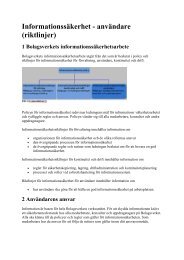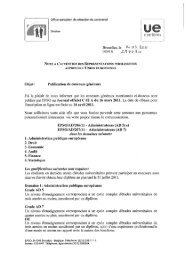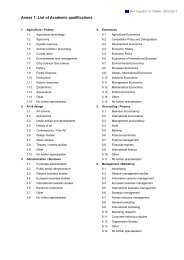Dialogkompetens i skolans vardag - Publikationer - LTU - Luleå ...
Dialogkompetens i skolans vardag - Publikationer - LTU - Luleå ...
Dialogkompetens i skolans vardag - Publikationer - LTU - Luleå ...
Create successful ePaper yourself
Turn your PDF publications into a flip-book with our unique Google optimized e-Paper software.
14 A.-C. Wennergren<br />
In different ways the whole group mentioned the importance of speaking<br />
one at a time:<br />
When one classmate is speaking the others have to listen, otherwise my ears will hurt<br />
(boy, 7).<br />
I don’t have to put up my hand before I start speaking. I can speak when someone else is<br />
finished (girl, 8).<br />
In rooms other than the classroom there are obviously fewer interruptions<br />
during the conversation. It is mentioned as important not to be interrupted.<br />
‘‘When I am sitting in the corridor nobody interrupts my listening’’ (girl, 14).<br />
When using technical equipment, it may be difficult to be aware of the<br />
intensity of voices. Some older pupils think it is easier to find a suitable range<br />
of voice in smaller groups or in smaller rooms. There are more opinions<br />
expressed about their classmates’ voices than about their own. With a lot of<br />
background noise, they make their voices increasingly louder and it is not that<br />
easy to know when it becomes too loud for some of the classmates:<br />
In this place I can listen. Nobody needs to raise their voice (girl, 15).<br />
With ordinary speech intensity it is clear to me what everybody is saying (boy, 15).<br />
A person can be either more or less sensitive to noises as a result of her/his<br />
hearing loss. The consequences do not only imply being more sensitive; soft<br />
sounds almost impossible for others to hear can also be perceived as noise<br />
(Arlinger 1999).<br />
Comments<br />
A communication situation demands that hard-of-hearing pupils invest<br />
a lot of energy into both listening and visual concentration, and might be<br />
one reason why pupils point out the need for conversation rules. If your<br />
concentration is on who is going to speak next, you can miss the opportunity<br />
to notice how each turn is taken. It might be tough to catch a voice signal,<br />
for example a change of tone, which is often the case when finishing a<br />
contribution. According to Wood, Bruner and Ross (1976), the teacher<br />
can take on the role of the scaffolding structuring expert concerning how<br />
to take part in the dialogue. But it is still a necessity to illuminate the<br />
unwritten rules of communication and maybe this is even more obvious<br />
when trying out different technical equipment. Vedeler (2004) found it typical<br />
for young hard-of-hearing children not to ask for clarification from their<br />
peers, but instead to appeal for help from adults, which has also been noted<br />
to be the case in the classroom setting (Ahlström & Preisler, 1998).<br />
The teacher is not a lifelong support in society one has to be aware<br />
of how to be a participant in everyday, out-of-school communication<br />
patterns. The scaffolding structure is only supposed to be a temporary<br />
guidance, in order to internalise new listening strategies based on what the<br />
pupils already know.

















